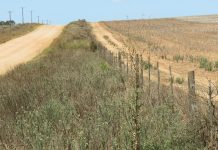The 2020/2021 season’s survey provided the results of the twenty-third annual wheat crop quality survey performed by the Southern African Grain Laboratory NPC (SAGL).
Due to a reduced amount approved for funding of this project, the number of samples analysed for the purpose of this survey had to be decreased to 250 individual samples, 49 composite samples per class and grade and 30 samples for mycotoxin analyses. No amino acid profile analyses were conducted this season. The samples were selected to provide as best possible a proportional representation of the production of wheat in all the different production regions.
Mycotoxins
Ongoing monitoring and continued research on the prevention and mitigation of mycotoxin contamination are of the utmost importance. The ISO/IEC 17025:2017-accredited multi-mycotoxin assessments included in the annual wheat crop quality survey for the past ten seasons, provide the most comprehensive overview of the multi-mycotoxin risk in commercial wheat produced and delivered to commercial grain storage companies in South Africa. Between 10% and 20% of the wheat crop samples were selected each season to proportionally represent the various production regions.
The absence of aflatoxin B1, B2, G1, G2, fumonisin B1, B2, B3, ochratoxin A, T-2 toxin and HT-2 toxin in the wheat samples over the past ten seasons were confirmed in the 2020/2021 season. Zearalenone (ZON) residues were detected on a wheat crop sample for the first time during the previous season, none was detected this season. The deoxynivalenol (DON) prevalence this season is the highest of the past ten seasons with 43% of the samples (13 out of 30 samples) testing positive for DON residues. The average value of the positive results was 891 µg/kg (ppb) and the highest value measured 3 088 µg/kg. Last season, six out of 40 samples (15%) tested positive for DON residues with an average value of 300 µg/kg (ppb), the highest value measured was 1 017 µg/kg. The average percentage of samples testing positive over the previous nine seasons is 14% and ranges from 3% to 25%.
According to Government Notice No. 987 of 5 September 2016, cereal grains (wheat, maize and barley) intended for further processing may not contain more than 2 000 µg/kg of DON. Further processing means any other treatment or processing method that have been proven to reduce levels of fungus-produced toxins in foodstuffs intended for human consumption. An example of this is the removal of the bran and outer layers of the wheat kernel during milling. Two of the positive residue levels measured this season exceeded this national maximum allowable level.
Application of good agricultural practices and storage conditions as well as effective mycotoxin risk management programs are essential elements in preventing the negative effects of mycotoxins.
Quality results
The national whole wheat protein average decreased from 12,9% in the previous season to 12%. The ten-year national average is 12,1%. The percentage samples from this crop survey with a protein content equal or higher than 12,5% (minimum protein content for super grade) was 42% (64,2% last season). The summer rainfall and irrigation areas of the Free State reported the highest whole wheat protein average, namely 13,5%. The production regions in the winter rainfall area of the Western Cape averaged 10,9% and the irrigation areas 12,9%. Flour protein content averaged 11,2% this season, 0,7% percent lower than the previous season. The protein content is reported on a 12% moisture basis.
An average hectolitre mass of 78,9 kg/hℓ equalled that of the previous season and is also the joint lowest average reported over the last eleven seasons, when the use of an instrument that complies to ISO standard 7971-3 (for example Kern 222) became compulsory. The ten-year national average is 80,4 kg/hℓ. 25 samples (10%) reported values below the 76 kg/hℓ minimum level for super grade, grade 1 and grade 2 wheat, of these eleven samples originated in the Western Cape (winter rainfall area), 13 in the Free State and one in KwaZulu-Natal. Regional averages ranged from 77,8 kg/hℓ in the Free State and 78,1 kg/hℓ in the Western Cape to 80,9 kg/hℓ in the irrigation areas.
1 000-kernel mass, reported on a 13% moisture basis, increased from 35,6 g last season to 38,2 g this season. The 2018/2019 season’s average was 39,2 g. Averages over production areas varied from 36,7 g in the summer rainfall and irrigation areas of the Free State to 37,4 g in the irrigation areas and 39,2 g in the winter rainfall areas.
The weighted average percentage screenings obtained with a 1,8 mm slotted sieve was 1,63%, compared to the 1,92% and 1,49% of the previous two seasons respectively. The summer rainfall and irrigation areas reported the highest average percentage, namely 2,16% and the irrigation areas the lowest of 1,07%. Of the 250 samples, 31 (12%) exceeded the 3% maximum permissible screenings level for super grade to grade 3. Most (55%) of these samples originated in the Western Cape.
This season the average falling number was 372 seconds, higher than the 353 seconds of last season’s average and slightly higher than the ten-year weighted average value of 369 seconds. 6,4% (16) of the samples analysed gave falling number values below 250 seconds. Of these, eleven (4%) were below 220 seconds and were downgraded to class other wheat (COW) as a result. These samples originated mainly from the Free State (N=8), with one sample each from Mpumalanga, North West and KwaZulu-Natal. Last season 8% of the samples analysed as part of the survey were downgraded to COW due to a low falling number. The highest regional average falling number value of 401 seconds this season was reported for the Western Cape and the lowest, namely 302 seconds, for the Free State. All falling number values reported are corrected for the altitude at which the test is performed.
The weighted mixogram peak time on flour milled on the Quadromat Junior mill averaged 3,2 minutes compared to the 3,0 minutes of the previous season and the 2,9 minutes of the ten-year average. The weighted mixogram peak time of the flour from the Bühler mill was 2,9 minutes, compared to the 2,6 minutes of the previous five seasons.
Wet gluten content (14% moisture basis) averaged 29,9% and the dry gluten, also on a 14% moisture basis, averaged 10,1%. The previous season these values averaged 31,1% and 10,6% respectively. The farinograph analysis resulted in an average water absorption of 59,3% (60,2% the previous season). The average alveogram strength was 38,3 cm² compared to the 42,6 cm² of the previous season. The average extensogram strength also decreased from 112 cm² in the previous season to 99 cm². The lower rheology values this season are expected, given the lower average protein content compared to the 2019/2020 season.
All national, seasonal and regional averages provided in this report are weighted averages.
For detailed results on this and all other quality testing performed on the survey samples, please refer to the SAGL website (www.sagl.co.za). The reports are also available in an easy-to-page format.
Wheat grades
According to the regulations detailed in Government Notice No. R. 1547 of 29 November 2019, the classes of wheat are bread wheat and other wheat. The grades for bread wheat are super grade, grade 1, grade 2 and grade 3. No grades are determined for COW.
The 250 representative crop samples received in the 2020/2021 season were graded as follows: 28% was graded as super grade, 14% was grade 1, 12% was grade 2, 12% was grade 3 and 34% was COW.
Of the 85 samples received that were downgraded to COW, 9% had a protein content lower than 9,5%; 13% had falling number values below 220 seconds; 11% had hectolitre mass values below 76 kg/hℓ; 35% had screening levels higher than 3%; 40% had other grain and unthreshed ear levels higher than 1%; 12% had insect-damaged kernel levels higher than 2%, 24% had total damaged kernel levels higher than 2%; 36% had combined/collective deviation levels exceeding 5% and 19% had field fungi levels higher than 2%. Single samples reported sprouted kernel and storage fungi percentages exceeding the maximum permissible deviation or the presence of poisonous seeds, undesirable odours and live insects. Most samples that were downgraded had more than one grading parameter below the minimum value required and/or higher than the maximum permissible deviation. 57% of the downgraded samples originated from the Western Cape, 28% from the Free State and 15% from the irrigation areas.
40% of wheat samples originating in the Free State were graded as super grade. 60% of the wheat samples from the irrigation areas and 7% of wheat samples from the Western Cape were graded as super grade. Please see Graphs 1 to 4 for the percentages of samples per class and grade, nationally as well as per production area, during the 2020/2021 season.




Imported wheat
During the 2019/2020 season, 1 889 868 tons of wheat were imported (from 28 September 2019 to 25 September 2020). This figure is 38% higher than the amount of wheat imported during 2018/2019. The ten-year import average is 1 669 632 tons. 57% of the wheat imported for local use during the 2019/2020 season originated in Poland (29%) and the Russian Federation (28%). A total number of 195 samples of imported wheat drawn by inspectors of the South African Agricultural Food, Quarantine and Inspection Services (SAAFQIS) of the Department of Agriculture, Land Reform and Rural Development (DALRRD) were received at the SAGL for analysis. Samples from the following ten countries were received (number of samples received in brackets): Canada (11), Finland (2), Germany (31), Latvia (8), Lithuania (28), Poland (45), the Russian Federation (48), the Ukraine (8) and the USA (14). The country of origin and vessel information of all samples received are verified against information received from the South African Grain Information Service (SAGIS).
Hectolitre mass is an important grading factor that also provides an indication of flour extraction potential. 4% of the samples had hectolitre mass values below 76 kg/hl (minimum requirement for South African super grade to grade 2 wheat). These samples originated mainly from Poland and Latvia.
Screenings represent all material that passes through a standard sieve (1,8 mm), with 3% the maximum allowed for super grade to grade 3 according to South African grading regulations. When comparing screening results originating from different countries, it is important to keep in mind that sieve aperture size and shape as well as sample preparation procedures vary between countries. Samples from the Ukraine, the Russian Federation, the USA and Poland reported the highest levels of screenings.
None of the samples reported falling number results below 220 seconds and all the country averages were well above 300 seconds. The South African national average for the same season was 353 seconds.
Composite samples of holds per shipment per country were tested for the presence of mycotoxin residues by means of a multi-mycotoxin analysis. The mycotoxin residue levels detected on the composite samples did not raise any major concerns. Most samples tested negative for all the mycotoxins analysed (aflatoxin B1, B2, G1, G2, fumonisin B1, B2, B3, DON, 15-ADON, HT-2 toxin, T-2 toxin, ZON and ochratoxin A). DON was the only mycotoxin found to be present on some of the samples. All these positive results were well below the national maximum allowable level of 2 000 µg/kg for cereals intended for further processing.
Detailed results of imported wheat samples per season and country are updated on a quarterly basis and are available on the SAGL website.
With gratitude to the Winter Cereal Trust for financial support of the annual crop and import surveys, to Agbiz Grain members for providing the crop samples as well as DALRRD inspectors at the harbours for providing representative samples of each shipment of imported wheat.




























